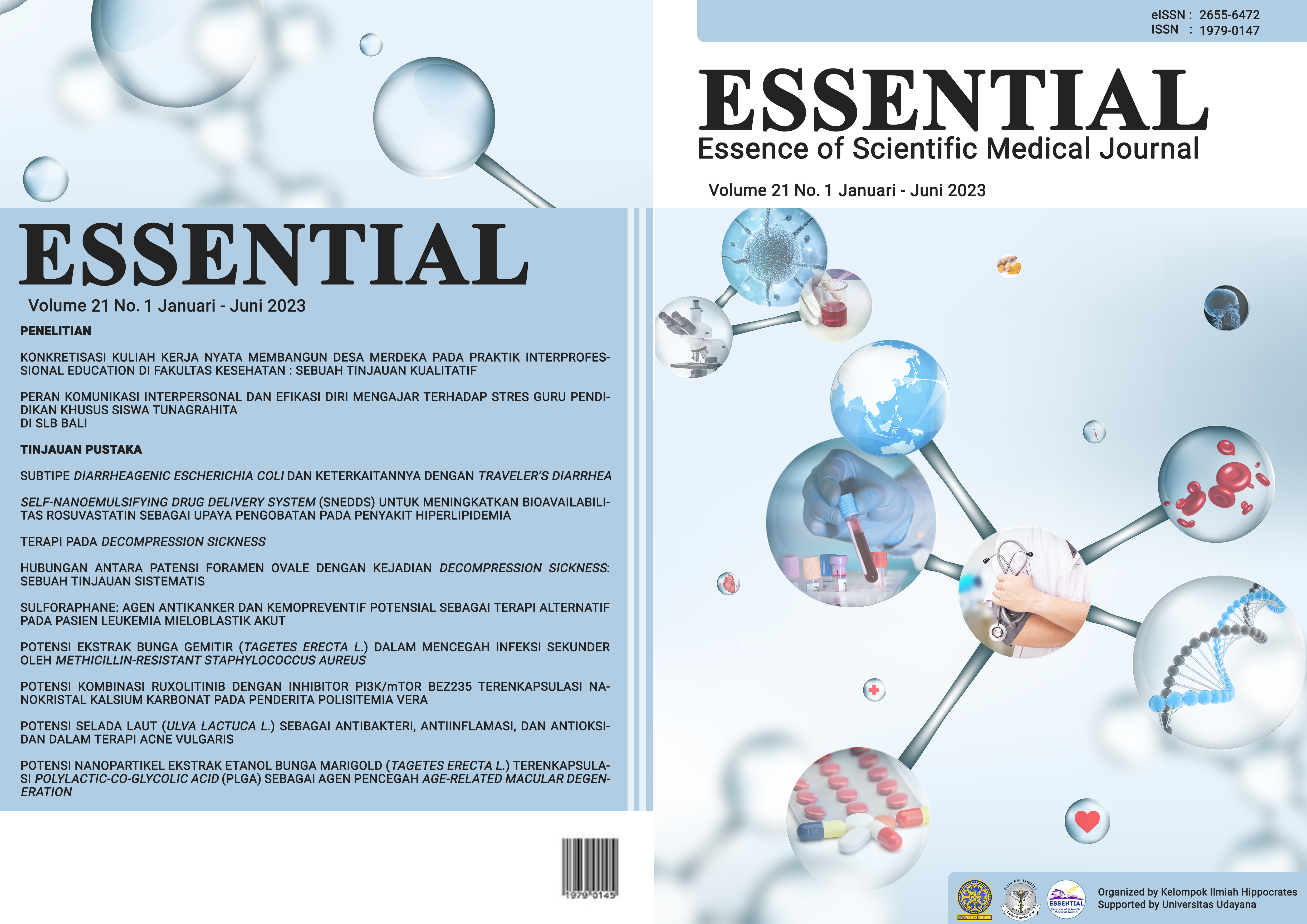Subtipe Diarrheagenic Escherichia coli dan keterkaitannya dengan Traveler’s Diarrhea
Abstract
ABSTRAK
Pendahuluan: Traveler’s diarrhea adalah penyakit diare yang dialami oleh turis, baik selama perjalanan atau ketika sudah kembali ke tempat asalnya. Hal ini disebabkan oleh berbagai faktor seperti higienitas bahan konsumsi turis dan perbedaan flora normal saluran pencernaan turis.
Pembahasan: Kontaminasi makanan dan minuman oleh feses yang mengandung patogen enterik Escherichia coli menjadi salah satu penyebab terbesar terjadinya traveler’s diarrhea. Penyakit ini ditransmisikan secara fekal-oral dan dapat sembuh dengan sendirinya, tetapi dapat mengganggu liburan atau aktivitas yang akan dilakukan akibat gejala yang ditimbulkan. Bakteri Escherichia coli memiliki karakteristik berbentuk batang, gram negatif dan bersifat fakultatif anaerob. Adapun gejala utama yang ditimbulkan adalah diare, tetapi juga dapat disertai dengan mual, demam, kram perut, muntah, dan pendarahan. Terdapat beberapa subtipe yang dapat ditemukan pada bakteri E.coli sehingga gejala klinis yang timbul cukup luas. Namun sebesar 15% pada kasus traveler’s diarrhea yang diakibatkan oleh Escherichia coli berasal dari subtipe Enterotoxigenic Escherichia coli, dimana diare berair tanpa adanya darah atau demam menjadi ciri khasnya. ETEC memiliki dua keluarga peptida, yaitu heat-stable toxin (ST) dan heat-labile toxin (LT), yang dapat mengganggu penyerapan cairan usus sehingga menyebabkan diare.
Simpulan: ETEC menjadi penyebab utama traveler’s diarrhea dengan menimbulkan gejala diare cair ringan hingga berat. Kajian ini diharapkan dapat menjadi acuan untuk perkembangan penelitian dan tindakan pencegahan ke depannya.
Kata kunci: Traveler’s diarrhea, Diarrheagenic Escherichia coli, Subtypes of Escherichia coli, ETEC
Downloads
References
[2] Steffen, R., Hill, D.R., and DuPont, H.L. Traveler’s Diarrhea: A Clinical Review. JAMA 2015;313:71. https://doi.org/10.1001/jama.2014.17006.
[3] Steffen, R. Epidemiology of Travellers’ Diarrhea. J Travel Med 2017;24:S2–5. https://doi.org/10.1093/jtm/taw072.
[4] Duplessis, C.A., Gutierrez, R.L., and Porter, C.K. Review: Chronic and Persistent Diarrhea with a Focus in the Returning Traveler. Trop Dis Travel Med Vaccines 2017;3:9. https://doi.org/10.1186/s40794-017-0052-2.
[5] Stoney, R.J., Han, P. V, Barnett, E.D., Wilson, M.E., Jentes, E.S., Benoit, C.M., MacLeod, W.B., Hamer, D.H., and Chen, L.H. Travelers’ Diarrhea and Other Gastrointestinal Symptoms Among Boston-Area International Travelers. Am J Trop Med Hyg 2017;96:1388–93. https://doi.org/10.4269/ajtmh.16-0447.
[6] Allocati, N., Masulli, M., Alexeyev, M., and Di Ilio, C. Escherichia coli in Europe: An Overview. Int J Environ Res Public Health 2013;10:6235–54. https://doi.org/10.3390/ijerph10126235.
[7] Kim, H.J., Koo, M., Jeong, A.-R., Baek, S.-Y., Cho, J.-I., Lee, S.-H., and Hwang, I.-G. Occurrence of Pathogenic Escherichia coli in Commercially Available Fresh Vegetable Products in Korea. J Korean Soc Appl Biol Chem 2014;57:367–70. https://doi.org/10.1007/s13765-014-4073-5.
[8] Croxen, M.A., Law, R.J., Scholz, R., Keeney, K.M., Wlodarska, M., and Finlay, B.B. Recent Advances in Understanding Enteric Pathogenic Escherichia coli. Clin Microbiol Rev 2013;26:822–80. https://doi.org/10.1128/CMR.00022-13.
[9] Hassan, M., Abou-Zeid, R., Hassan, E., Berglund, L., Aitomäki, Y., and Oksman, K. Membranes Based on Cellulose Nanofibers and Activated Carbon for Removal of Escherichia coli Bacteria from Water. Polymers (Basel) 2017;9:335. https://doi.org/10.3390/polym9080335.
[10] Tang, Y., Li, Z., Luo, Q., Liu, J., and Wu, J. Bacteria Detection based on Its Blockage Effect on Silicon Nanopore Array. Biosens Bioelectron 2016;79:715–20. https://doi.org/10.1016/j.bios.2015.12.109.
[11] Reshes, G., Vanounou, S., Fishov, I., and Feingold, M. Cell Shape Dynamics in Escherichia coli. Biophys J 2008;94:251–64. https://doi.org/10.1529/biophysj.107.104398.
[12] Hasman, H., Schembri, M.A., and Klemm, P. Antigen 43 and Type 1 Fimbriae Determine Colony Morphology of Escherichia coli K-12. J Bacteriol 2000;182:1089–95. https://doi.org/10.1128/JB.182.4.1089-1095.2000.
[13] Gurtler, J.B. Evaluation of Plating Media for Recovering Salmonella from Thermally Treated Egg Albumen. J Appl Poult Res 2009;18:297–309. https://doi.org/10.3382/japr.2008-00109.
[14] Leininger, D.J., Roberson, J.R., and Elvinger, F. Use of Eosin Methylene Blue Agar to Differentiate Escherichia Coli from Other Gram-Negative Mastitis Pathogens. J Vet Diagnostic Investig 2001;13:273–5. https://doi.org/10.1177/104063870101300319.
[15] Taha, Z.M. and Yassin, N.A. Prevalence of Diarrheagenic Escherichia coli in Animal Products in Duhok Province, Iraq. Iran J Vet Res 2019;20:255–62.
[16] Aijuka, M. and Buys, E.M. Persistence of Foodborne Diarrheagenic Escherichia coli in the Agricultural and Food Production Environment: Implications for Food safety and Public Health. Food Microbiol 2019;82:363–70. https://doi.org/10.1016/j.fm.2019.03.018.
[17] Elder, J.R., Fratamico, P.M., Liu, Y., Needleman, D.S., Bagi, L., Tebbs, R., Allred, A., Siddavatam, P., Suren, H., Gujjula, K.R., DebRoy, C., Dudley, E.G., and Yan, X. A Targeted Sequencing Assay for Serotyping Escherichia coli Using AgriSeq Technology. Front Microbiol 2021;11:1–8. https://doi.org/10.3389/fmicb.2020.627997.
[18] Durand, D., Mercado, E., Riveros, M., Ochoa, T.J., Ruiz, J., García, W., and García, C. Molecular and Phenotypic Characterization of Diarrheagenic Escherichia coli Strains Isolated from Bacteremic Children. Am J Trop Med Hyg 2017;97:1329–36. https://doi.org/10.4269/ajtmh.17-0066.
[19] Askari Badouei, M., Jajarmi, M., and Mirsalehian, A. Virulence Profiling and Genetic Relatedness of Shiga Toxin-producing Escherichia coli Isolated from Humans and Ruminants. Comp Immunol Microbiol Infect Dis 2015;38:15–20. https://doi.org/10.1016/j.cimid.2014.11.005.
[20] Cabrera-Sosa, L. and Ochoa, T.J. Escherichia coli Diarrhea. In: Ryan ET, Hill DR, Solomon T, Aronson NE, Endy TPBT-HTM and EID (Tenth E, editors. Hunter’s Trop. Med. Emerg. Infect. Dis., London: Elsevier; 2020, p. 481–5. https://doi.org/10.1016/B978-0-323-55512-8.00046-6.
[21] Gelberg, H.B. Alimentary System and the Peritoneum, Omentum, Mesentery, and Peritoneal Cavity. In: Zachary JFBT-PB of VD (Sixth E, editor. Pathol. Basis Vet. Dis. 6th ed., Elsevier; 2017, p. 324-411.e1. https://doi.org/10.1016/B978-0-323-35775-3.00007-2.
[22] Mellata, M. Human and Avian Extraintestinal Pathogenic Escherichia coli: Infections, Zoonotic Risks, and Antibiotic Resistance Trends. Foodborne Pathog Dis 2013;10:916–32. https://doi.org/10.1089/fpd.2013.1533.
[23] Harro, C., Louis Bourgeois, A., Sack, D., Walker, R., DeNearing, B., Brubaker, J., Maier, N., Fix, A., Dally, L., Chakraborty, S., Clements, J.D., Saunders, I., and Darsley, M.J. Live attenuated enterotoxigenic Escherichia coli (ETEC) vaccine with dmLT adjuvant protects human volunteers against virulent experimental ETEC challenge. Vaccine 2019;37:1978–86. https://doi.org/10.1016/j.vaccine.2019.02.025.
[24] Laxmi, S., Jianyi, Y., Magdalena, K., Katia, K., James, K., James, F., and Mark, D. Mechanical Stimuli Affect Escherichia coli Heat-Stable Enterotoxin-Cyclic GMP Signaling in a Human Enteroid Intestine-Chip Model. Infect Immun 2020;88:e00866-19. https://doi.org/10.1128/IAI.00866-19.
[25] Mirhoseini, A., Amani, J., and Nazarian, S. Review on Pathogenicity Mechanism of Enterotoxigenic Escherichia coli and Vaccines against It. Microb Pathog 2018;117:162–9. https://doi.org/10.1016/j.micpath.2018.02.032.


 SUBMISSION
SUBMISSION
















